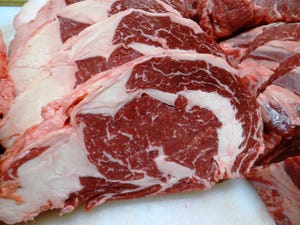Grazing system helps young farmers enter cattle business
The MU Southwest Center studies "double" stocker calf operations on fescue.
April 15, 2021

Eric Bailey, University of Missouri Extension beef nutrition specialist, is looking at how to graze the same number of calves in half the time for better weight gains.
It is part of a three-year study with researchers at the University of Missouri’s Southwest Research Center in Mount Vernon on determining if beef producers can improve profits through a “double” calf stocking and grazing plan.
This grazing enterprise matches Missouri’s tall fescue growth curve and could lead to opportunities for producers with limited capital and equipment to enter the cattle business, Bailey says.
The plan focuses on grazing tall fescue when it is at its peak in growth and nutrition, and then pulling calves off pastures before fescue quality begins to decline.
Success depends largely on understanding when tall fescue yields the most nutrition for the most gain, Bailey says.
Grazing timing
Two-thirds of tall fescue growth occurs in the spring. Quality peaks in April and drops significantly by July. The other third of tall fescue forage grows in the fall.
Many operations do not have enough cows to graze all of the flush of spring fescue. As a result, most harvest the excess spring growth as dry hay.
Timing of hay harvest affects feed quality. Bailey points to a University of Tennessee study that shows that cattle eat more, gain more and get more nutrients in early May when fescue is in late boot to head stage.
The Tennessee research shows that fescue yields significantly affect daily gain rates. Cattle gain most in early May when each cow takes in 13 pounds of fescue per day for a 1.39-pound gain. This also is when total digestible nutrients are highest.
By mid-May, cattle reduced fescue intake to 11.7 pounds per day and gained 0.97 pounds per day. TDN dropped slightly as yield per acre increased.
By the end of May, cattle ate 8.6 pounds of feed and gained only 0.42 pounds per day, with a lower TDN of 56. Yield increased significantly, and hay was forming early milk or seed.
Looking to the West
Bailey’s plan mimics the “double stocking” or “intensive early stocker” grazing strategy Kansas State University researchers used in the Flint Hills of Kansas in the 1970s.
The MU researchers initially set out two years ago to test the interaction of nitrogen and an herbicide intended to control tall fescue seed heads. They pulled calves off pastures before July 4 to avoid the summer slump.
In this process, they noticed major weight gains in the calves.
Average daily gain was 1.55 pounds in the control treatment with no nitrogen or herbicide control, or about twice what is reported in similar research, Bailey says.
Bailey attributes this to grazing pastures for half the time with twice the number of cattle.
This concept worked well in the Flint Hills of Kansas, but at a much lower stocking rate than Missouri.
“We have a tremendously productive forage system in Missouri,” Bailey says. “Other states talk about acres per head. We will talk about head per acre, if this concept takes off.”
Bailey says this system offers potential for producers with limited capital and equipment to enter the cattle business. “Imagine a custom-grazing scenario where someone sends you calves to graze on land that you have leased. It is not a capital-intensive business model,” he says.
Source: University of Missouri Extension, which is solely responsible for the information provided and is wholly owned by the source. Informa Business Media and all its subsidiaries are not responsible for any of the content contained in this information asset.
You May Also Like



